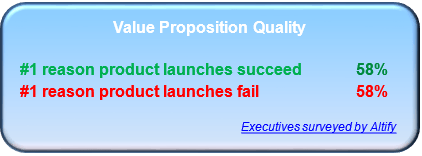Whether you believe that product launch failure rates are only 40% or are closer to 65-75%, getting product launches right is important. To drive continued profit growth with innovative products, the best B2B companies splice a strong product development and launch process into their cultural DNA. Scott J. Edgett of Stage-Gate® International estimates that over 80% of North American companies use some form of a Stage-Gate innovation model. R.G. Cooper estimates a higher percentage in Europe. Well-defined processes for the development and launch of new products are essential to maximize the speed, efficiency, and revenue impact of research, development and launch efforts.
 Customer Value & Product Launch Success. Customer-centricity tops the list of Edgett’s five proven success ingredients for a good Stage-Gate process. As he puts it, “Customer focused innovation drives success rates that are twice as high in the marketplace and have a much higher productivity rate (4.5 times). It is the number one key to success and profitability.” Edgett says that “the goal is to maintain a sharp focus on developing and delivering new products that are differentiated, solve major customer problems, and offer compelling value propositions to the customer.”
Customer Value & Product Launch Success. Customer-centricity tops the list of Edgett’s five proven success ingredients for a good Stage-Gate process. As he puts it, “Customer focused innovation drives success rates that are twice as high in the marketplace and have a much higher productivity rate (4.5 times). It is the number one key to success and profitability.” Edgett says that “the goal is to maintain a sharp focus on developing and delivering new products that are differentiated, solve major customer problems, and offer compelling value propositions to the customer.”
 In a survey by Altify, executives identified Value Proposition quality as the number one reason for product launch successes and for product launch failures. Strong Value Propositions enable better product launch decisions, including pricing and offer design. Strong Value Propositions support sales confidence and are an efficient way for marketing and sales teams to understand and communicate what a new product delivers to their customer.
In a survey by Altify, executives identified Value Proposition quality as the number one reason for product launch successes and for product launch failures. Strong Value Propositions enable better product launch decisions, including pricing and offer design. Strong Value Propositions support sales confidence and are an efficient way for marketing and sales teams to understand and communicate what a new product delivers to their customer.
Stephan Liozu connects value based pricing with effective innovation. He stresses the need for a Value Proposition and a quantitative understanding of value early in the innovation process as critical to capturing the value of a new product in its price. “If you have a game-changing innovation and are struggling to estimate differential value, do not improvise or do not simply give up.”
Great organizations assure that their gated development and launch processes focus on B2B customers by making Value Propositions a central requirement. They prescribe specific customer value deliverables at specific gates. Organizational approaches vary, with different companies requiring different value deliverables at different gates. Organizations who embed customer value in their process learn from the insights they obtain, the decisions they make, and the results they achieve. With experience, these organizations migrate toward: (1) understanding differential value on an increasingly quantitative basis, and (2) understanding value earlier in the development process.
The Importance of Live Gate Reviews. Product managers, on reflection, usually admit to the benefits, notwithstanding the pain, of preparing structured, templated materials for their Stage-Gate process.
But the central event in any Stage-Gate process is the live gate review. It is the equivalent of a board meeting for a product CEO. The review date is a deadline for preparing strategic materials. The event itself is a forum for gate reviewers to stress test product managers’ thinking in order to make better strategic decisions. In the live gate review, the best reviewers ask good questions and provide the benefit of their cross-functional expertise and experience. Their objective is to improve product development and launch plans and to make better consensus product management decisions.
Three Essential Questions a Gate Reviewer Should Ask. Good gate reviewers do not need extensive value quantification experience to generate insights from customer value in the gate review process. There are three essential questions about a Value Proposition that a gate reviewer should ask. These questions are fundamental:
- Persuasive. Is our Value Proposition persuasive?
- Relevant. Will our new product be broadly valuable across the addressable market?
- Reasonable. How much of the value of our innovation will our pricing strategy let us realize?
The answers to these questions often go a long way toward revealing the quality of the Value Proposition. This in turn reflects on the merits and gaps in the product launch plan, helping to identify important refinements and investments that a product manager needs to make to improve it.
Let’s look at each of these questions in greater depth:
 1. If I were a customer, would the Value Proposition presented to me be persuasive? Gate reviewers, at some point in their evaluation, need to put themselves in the customer’s shoes. A Value Proposition stimulates customer-centric thinking. Good gate reviewers often ask a product manager to “present your Value Proposition as if I were a customer.”
1. If I were a customer, would the Value Proposition presented to me be persuasive? Gate reviewers, at some point in their evaluation, need to put themselves in the customer’s shoes. A Value Proposition stimulates customer-centric thinking. Good gate reviewers often ask a product manager to “present your Value Proposition as if I were a customer.”
A Value Proposition presented this way invites the gate reviewer to make an honest assessment of customer decisions. “If I received a sales presentation of this Value Proposition, would I buy the product?” “Could I use the business case provided by this Value Proposition to defend buying the product in an internal budget review or a procurement process?” It also signals whether the Value Proposition is sales-ready.
The potential follow-up questions are many. “Why should the customer care about this feature?” “Is our product relevant to the customer’s problems or needs?” “Tell me more about the customer’s process that we improve.” “How strong are our product’s claims for delivering results?” Answers to these questions are revealing. They show how well product managers understand the customer, their most important audience. They tend to expose whether a product manager is driving technical development of product features toward customer needs, benefits, and outcomes. Often the conversation about the Value Proposition’s persuasiveness highlights messages that should be emphasized or de-emphasized. It can also help inform product positioning.
An honest evaluation of a Value Proposition may be that it is NOT persuasive. At least not yet. This is why we do gate reviews. If a Value Proposition is not persuasive, is it at least plausible? If so, that means we need to do some work to move it from plausible to persuasive. “What additional information do we need to make it persuasive?” “Can we interview alpha customers or beta customers?” “Is there a reasonable investment that will improve the quality of the Value Proposition’s supporting information?” “How should this work figure into messaging and go-to-markets plans for the product?”
If the Value Proposition is neither persuasive nor plausible, the problem is potentially more fundamental. Perhaps some near-term, focused work can clarify the product’s differentiation and the resulting customer benefits enough to formulate value hypotheses. If not, this should cast doubt on the wisdom of moving forward through the gate with the product under consideration, its product manager, or both.
 2. Will the Value Proposition presented resonate with a substantial portion of the product’s market? Having started in the customer’s shoes, it is natural to consider: (a) which customer stakeholders are likely to understand and appreciate the value and (b) which customer accounts are likely to find the Value Proposition relevant. Identifying stakeholders with whom the value is most likely to resonate supports our marketing as we identify target personnae and tailor value messages. If the Value Proposition is relevant only to narrow segments within the addressable market, we should ask about the value for other segments. “How would the Value Proposition differ?” “Can we modify the Value Proposition to make it persuasive in those segments?”
2. Will the Value Proposition presented resonate with a substantial portion of the product’s market? Having started in the customer’s shoes, it is natural to consider: (a) which customer stakeholders are likely to understand and appreciate the value and (b) which customer accounts are likely to find the Value Proposition relevant. Identifying stakeholders with whom the value is most likely to resonate supports our marketing as we identify target personnae and tailor value messages. If the Value Proposition is relevant only to narrow segments within the addressable market, we should ask about the value for other segments. “How would the Value Proposition differ?” “Can we modify the Value Proposition to make it persuasive in those segments?”
Often, extending the value picture more widely across the addressable market is a straightforward pursuit that may take additional work, but also helps to define better segmentation. Recognizing differences in value between potential buyers, identifying discovery questions that can help customize value messages, and considering offerings that are better targeted by segment are all constructive outcomes that help refine our go-to-market strategy.
If it is difficult to adapt the Value Proposition for segments not yet addressed, perhaps we should be skeptical about the potential size of the market. Given that any good gate review material includes some version of addressable market size, reassessing potential market size is a useful, if painful, result of the gate review.
3. Does the proposed launch price capture a reasonable amount of the value of our product? This question sometimes causes discomfort. Frequently, a proposed pricing plan is based on cost calculations. Sometimes, pricing is based directly on the price of competitors without considering how to increase profitability by charging a premium price.
The “how much value can we capture?” conversation hits the reset button on price thinking. Launching more valuable B2B products is why we innovate. Why aren’t we trying to capture a reasonable percentage of that value?
 Sometimes there are good answers based on the type of value we provide, customer buying factors, or our pricing strategy over time. If our innovative product provides a gateway to a new account base or gives us a short head-start on the competition, setting prices to penetrate the market, even if we capture a modest portion of our differentiated value, may make sense. If our performance is perceived as uncertain, if our competitor’s quality is accepted as superior, or if our reputation is tarnished, less aggressive pricing may represent a reasonable response to our competitive position.
Sometimes there are good answers based on the type of value we provide, customer buying factors, or our pricing strategy over time. If our innovative product provides a gateway to a new account base or gives us a short head-start on the competition, setting prices to penetrate the market, even if we capture a modest portion of our differentiated value, may make sense. If our performance is perceived as uncertain, if our competitor’s quality is accepted as superior, or if our reputation is tarnished, less aggressive pricing may represent a reasonable response to our competitive position.
Just as often, however, the answer to “why not capture more value?” sheds further light on the persuasiveness of the Value Proposition itself. The reluctance of a product manager to charge a value-based premium sometimes reveals additional work required to make the Value Proposition more robust at launch. It can also highlight segments that were not included in the original Value Proposition that are weighing on the product manager’s thought process about pricing.
With a strong Value Proposition, the “why not capture more value?” question highlights our product’s differentiated value, bolstering a team’s courage to target a higher price. This is exactly why value disciplines are embedded in the gate review. Asking about the reasonableness of value capture also helps to focus the team’s mind on the right messages that will get customers to pay a premium price. If improving the strength of the Value Proposition for different segments is one of the priorities that emerges from the gate review, then it is useful to think about the pricing implications of investing time and money in further marketing and supporting information. This sheds light on the ROI of extra launch spend versus not investing.
Finally, the value-based pricing question helps us think about the challenges of the launch. It generates conversations about what it will take to get early adopters to buy and to provide more customer experience with our product post-launch. It sheds light on our dynamic pricing strategy through time, as we gradually obtain more data about our product’s differentiated performance and about the accounts who succeed most effectively when they purchase our product.
Reviewing a Value Proposition in a gate review should be more than a procedural checkbox. Good gate reviewer questions about customer value provide information that informs and defines next steps.
 The Value of Value Propositions in New Product Launch. Building Value Propositions supports better product launch decisions, including product positioning, price setting, segmentation, and offer design. The sooner value hypotheses are formulated in the product or solution development process, the sooner they can be tested in customer interviews, product performance studies, and market research. The process of understanding and refining value hypotheses not only helps establish value-based pricing for the product, but it often provides insights into product positioning. A deeper understanding of value helps to identify value and need based differences between accounts that form the basis for effective segmentation and for the design of better offerings to fit those segments. Quantifying and dollarizing value early provides customer insights that improve the go-to-market strategy for the product. The evidence shows that implementing a value based-pricing strategy improves EBITDA by an average of 8%[1] and that the ROI of investing in value based strategies ranges from 130% to 900%.[2]
The Value of Value Propositions in New Product Launch. Building Value Propositions supports better product launch decisions, including product positioning, price setting, segmentation, and offer design. The sooner value hypotheses are formulated in the product or solution development process, the sooner they can be tested in customer interviews, product performance studies, and market research. The process of understanding and refining value hypotheses not only helps establish value-based pricing for the product, but it often provides insights into product positioning. A deeper understanding of value helps to identify value and need based differences between accounts that form the basis for effective segmentation and for the design of better offerings to fit those segments. Quantifying and dollarizing value early provides customer insights that improve the go-to-market strategy for the product. The evidence shows that implementing a value based-pricing strategy improves EBITDA by an average of 8%[1] and that the ROI of investing in value based strategies ranges from 130% to 900%.[2]
Every product launch team should have a powerful sales-ready Value Proposition at launch. CRM data from B2B organizations adopting value selling show that opportunities where a Value Proposition is used have 5-15% higher win rates and 5-25% higher price outcomes. Strong Value Propositions support sales confidence and are an efficient way for marketing and sales teams to understand and communicate what a new product delivers for the customer. A Value Proposition, developed and tested prior to launch, serves as a critical piece of content to train sales teams and support them in their early customer discussions. The Value Proposition helps sales teams understand the business outcomes a customer can expect by buying the product, a critical component of training. It provides content for customer conversations, helping sales to qualify accounts and move qualified prospects through a buying process. In order to have a Value Proposition sales-ready at launch, a commercial team needs to start understanding value early in development to build a presentable Value Proposition that can be tested by sales mobilizers and refined by product managers and the marketing team.
All great B2B organizations are customer-centric. Value conversations bring the customer’s business problems into focus, highlighting our differentiation in terms of the outcomes we deliver. Value reviews should be a central part of gate reviews. By taking value quantification seriously, gate reviewers improve the quality of gated development decisions, killing bad projects earlier, improving development programs, and designing better go-to-market strategies. By taking Value Propositions seriously, gate reviewers improve the success of the products that make it through the gates by driving faster sales velocity at launch.
To learn more about how to coach product managers to quantify value see:
The Value Coach’s Playbook Part 1 – Quantify Value
To learn more about how to embed value in your organization see:
Align Strategy with Customer Journeys: Best Practices to Adopt Value Management
[1] See John Hogan, “Building a World-Class Pricing Capability: Where Does Your Company Stack Up?” Monitor Group Perspectives, 2008.
[2] See Stephan Liozu and Andreas Hinterhuber, eds., The RoI of Pricing, Measuring the Impact and Making the Business Case (Routledge, 2014), especially the chapter by Stephan Liozu, “RoI and the impact of pricing: the state of the profession.”

